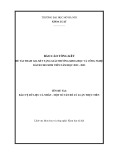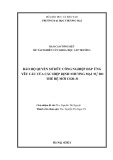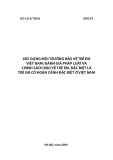
STUD Y PROT O C O L Open Access
Marketing depression care management to
employers: design of a randomized
controlled trial
Kathryn M Rost
1*
, Donna Marshall
2
Abstract
Background: Randomized trials demonstrate that depression care management can improve clinical and work
outcomes sufficiently for selected employers to realize a return on investment. Employers can now purchase
depression products that provide depression care management, defined as employee screening, education,
monitoring, and clinician feedback for all depressed employees. We developed an intervention to encourage
employers to purchase a depression product that offers the type, intensity, and duration of care management
shown to improve clinical and work outcomes.
Methods: In a randomized controlled trial conducted with 360 employers of 30 regional business coalitions, the
research team proposes to compare the impact of a value-based marketing intervention to usual-care marketing
on employer purchase of depression products. The study will also identify mediators and organizational-level
moderators of intervention impact. Employers randomized to the value-based condition receive a presentation
encouraging them to purchase depression products scientifically shown to benefit the employee and the
employer. Employers randomized to the usual-care condition receive a presentation encouraging them to monitor
and improve quality indicators for outpatient depression treatment. Because previous research demonstrates that
the usual-care intervention will have little to no impact on employer purchasing, depression product purchasing
rates in the usual-care condition capture vendor efforts to market depression products to employers in both
conditions while the value-based intervention is being conducted. Employers in both conditions are also provided
free technical assistance to undertake the actions each presentation encourages. The research team will use intent-
to-treat models of all available data to evaluate intervention impact on the purchase of depression products using
a cumulative incidence analysis of 12- and 24-month data.
Discussion: By addressing the ‘value to whom?’question, the study advances knowledge about one of the most
pivotal problems in the translation of evidence-based care to ‘real world’settings: whether purchasers can be
influenced to buy healthcare products on the basis of value and not exclusively on the basis of cost. If value-based
marketing increases depression product purchase rates over usual care, this study will provide encouragement to
market new healthcare products on the basis of the product’s value to the purchaser as well as the recipient
of care.
Trial Registration: Clinical Trials Registration Number: NCT01013220
* Correspondence: kathryn.rost@med.fsu.edu
1
Department of Medical Humanities and Social Sciences, Florida State
University College of Medicine, Tallahassee, Florida, USA
Rost and Marshall Implementation Science 2010, 5:22
http://www.implementationscience.com/content/5/1/22
Implementation
Science
© 2010 Rost and Marshall; licensee BioMed Central Ltd. This is an Open Access article distributed under the terms of the Creative
Commons Attribution License (http://creativecommons.org/licenses/by/2.0), which permits unrestricted use, distribution, and
reproduction in any medium, provided the original work is properly cited.

Background
Recent studies estimate that 7.6% of employees suffer a
major depressive episode each year [1]. Depression sub-
stantially reduces an employee’s ability to work, as evi-
denced by increased absenteeism [2-5] and reduced
productivity at work (hereafter referred to as productiv-
ity) [2-7], with annual work costs approaching $24 billion
(Y2K$) [1]. As the most prevalent disorder of the five
conditions that cause the greatest work loss in the Amer-
ican workforce [8,9], depression will soon become the
leading cause of disability in industrialized countries [10].
Employers can reduce their depression-related work
losses by ensuring their employees receive the type,
intensity and duration of depression care management
shown to improve clinical and work outcomes in effec-
tiveness trials [11-14]. Employers, who finance health
insurance coverage for an estimated 90% of non-elderly
individuals with private health insurance [15], can pur-
chase products that increase the probability that their
depressed employees receive this evidence-based care.
Interventions to increase product purchase need to
increase employer motivation and capacity to purchase.
Increasing employer motivation to purchase
In the studies to date, employers report substantial
information deficits about the costs that organizations
absorb when depressed employees fail to receive ade-
quate treatment. Employers who receive this informa-
tion report interest in reviewing the data that depression
products achieve a return on investment. Even more
encouragingly, employers notethattheyarewillingto
apply program savings from improved absenteeism and
productivity against program costs [16-24].
Increasing employer capacity to purchase
Employers interested in purchasing a depression product
that provides value face non-trivial challenges. Employ-
ers who contract with multiple health plans have to
contract with an additional vendor (e.g., a disease man-
agement company or managed behavioral health organi-
zation) to provide a depression product to their
workforce. Because the marketplace does not currently
provide a list of vendors who sell depression products,
interested employers often know only those products
recommended by their colleagues. Not surprisingly, pro-
ducts differ substantially in their cost and capacity to
deliver evidence-based services, requiring employers to
make informed choices despite imperfect information
to realize value for themselves or their employees. To
address this need, this study provides technical assis-
tance to employers to identify high-quality depression
products, referring to products that provide the type,
intensity, and duration of depression care management
shown to improve clinical and work outcomes as
Depression Management in the Workplace (DMW)
products.
Scope of Study
The specific aims of the study are: to compare the
impact of value-based (VB) and usual-care (UC) inter-
vention on employer purchase of depression products;
to identify mediators of intervention impact on
employer purchase; and to identify organizational-level
moderators of employer purchase.
The first specific aim utilizes an experimental design
to study intervention effectiveness. Hypothesis one tests
whether VB intervention significantly increases purchas-
ing behavior over UC. The second specific aim utilizes a
non-experimental design to study intervention media-
tors. Hypothesis two tests whether intervention impact
on purchasing behavior is mediated by the organiza-
tion’s appraisal of product benefit to the employer more
than the employee. Hypothesis three tests whether col-
leagues influence an organization’s appraisal of product
benefit to employer. The third specific aim utilizes a
non-experimental design to study intervention modera-
tors. Hypothesis four tests whether larger and more
mature companies with greater financial latitude
demonstrate higher levels of purchasing behavior, as
well as companies who make greater investments in
their employees and have a higher tolerance for benefit
risk, independent of intervention. Hypothesis five tests
whether companies with de-centralized onsite purchas-
ing groups in which the presentation participant has pri-
mary influence will demonstrate higher levels of
purchasing behavior, independent of intervention.
Hypothesis six tests whether companies with strong
vendor relationships demonstrate higher levels of pur-
chasing behavior, independent of intervention.
Before initiating the study, the research team: fully
articulated a conceptual framework; pilot tested the VB
intervention prototype to demonstrate intervention fea-
sibility, to collect/integrate employer feedback to further
strengthen the intervention, and to estimate effect size;
created instrumentation to measure intervention media-
tors, moderators, and outcomes with demonstrated
reliability and validity; investigated business coalition
interest in participating in the study; and received
approval from the Florida State University Institutional
Review Board.
Methods/design
Participants and setting
Regional Coalitions
Employers join coalitions in their geographic area to
identify innovative solutions to provide quality
Rost and Marshall Implementation Science 2010, 5:22
http://www.implementationscience.com/content/5/1/22
Page 2 of 7

healthcare at affordable prices, focusing on benefit pro-
ducts for their non-unionized employees. The 58 coali-
tion members of the National Business Coalition on
Health (NBCH) are eligible to participate in the study if:
they have 30 or more current employer purchasers as
members/affiliates; have hosted presentations in regu-
larly scheduled meetings during the past year (eliminat-
ing a limited number of coalitions who served
exclusively as purchasing agents); and have not partici-
pated in the research team’s preliminary studies. The
research team, in conjunction with the NBCH Board of
Directors, sends eligible coalitions an invitation to parti-
cipate, followed up by a telephone call, describing the
purpose of the study as testing two educational presen-
tations on assuring high quality depression care.
Employers
Employers who belong to regional coalitions are eligible
to participate if: they represent a public or private com-
pany that provides health benefits to 100 or more
domestic employees; their company intends to remain
in the regional coalition for the next two years; and the
coalition’s Executive Director does not indicate they
have purchased depression products for all their
employees in the past two years. Employers who join
regional coalitions appoint one employee from their
company to represent them. Unpublished studies indi-
cate that more than 60% of these representatives report
strong influence in benefit purchasing decisions. The
Executive Director of each participating coalition distri-
butes a fact sheet to all eligible representatives inviting
them to participate in a study that tests two educational
presentations about how companies can improve the
depression treatment their employees receive. The
Executive Director follows up with each member by tel-
ephone to confirm that 6 or more employers agree to
participate in the study without knowing which condi-
tion they will be assigned to.
Randomization
Participating coalitions are randomized to one of six
quarters ending March 2011 for presentation to reduce
historical threats to validity in non-experimental
analyses. As shown in Figure 1, participating employers
within a coalition are block randomized by workforce
size to the VB or UC condition. After being alphabe-
tized, all participating employers are assigned a unique
two-digit number from a random numbers table created
by the principal investigator at a centralized location
blinded to all company names. Each participating
employer is matched to another participating employer
inthesamecoalitionbyworkforcesizebeforethe
employer with the higher number in each pair is rando-
mized to the VB condition with the other member ran-
domized to the UC condition. When randomization is
completed in each coalition, a member of the research
team works with the Executive Director to invite partici-
pating employers to the presentation to which they had
been randomized. Participants remain blind to interven-
tion condition until the presentation begins.
Intervention
The intervention consists of a presentation and technical
assistance delivered to employer representatives at local
meetings sponsored by regional coalitions. Employers
randomized to the VB condition receive the Depression
Management in the Workplace (DMW) presentation.
Employers randomized to the UC condition receive the
Healthcare Effectiveness Data and Information Set
(HEDIS) presentation. All interested employer represen-
tatives are offered condition-specific technical assistance
free of charge during the 24 months after the
presentation.
Presentations
The DMW and HEDIS presentations present the con-
tent summarized in Table 1 utilizing high quality gra-
phic material recently awarded The Communicators
Award of Excellence in an international competition.
DMW presentation
The two-hour DMW presentation educates employer
representatives about DMW Care and its evidence-
based impact on clinical and work outcomes. Employer
representatives receive a company-specific return on
investment (ROI) estimate associated with DMW Care.
As shown in Table 2, this estimate is generated by a
Figure 1 Research Design.
Rost and Marshall Implementation Science 2010, 5:22
http://www.implementationscience.com/content/5/1/22
Page 3 of 7

calculator the research team developed in its earlier stu-
dies by translating scientifically derived estimates of
DMW Care’s impact on absenteeism and productivity at
work to a monetized savings in lost work days, varying
pertinent employee, organizational, and vendor charac-
teristics [25]. During the presentation, employers are
encouraged to explore purchasing a depression product
for their company and to request free technical assis-
tance to help them purchase a DMW Care quality
product.
HEDIS presentation
The two-hour HEDIS presentation educates employers
about HEDIS indicators for antidepressant medication
management and their use in monitoring outpatient
depression treatment quality. Employers receive HEDIS
indicators for antidepressant medication management
for their most subscribed plan if that plan reports its
HEDIS scores to the National Committee for Quality
Assurance; otherwise, they receive the HEDIS indicators
for other plans in the area. During the presentation,
employers are asked to encourage their most subscribed
health plan to improve its HEDIS indicators for depres-
sion (or to calculate its HEDIS indicators if it does not
report them). In addition, employers are encouraged to
ask their plans to provide individual feedback to clini-
cians about the quality of their depression care, provide
Table 1 Presentation Schematic
Sequence of Initial Activities VB Presentation UC Presentation
PRESENTATION Prevalence in the workplace Prevalence in society
Depression burden to
Employer Depression burden to individual
Employee
Problems treating depression in usual care Problems treating depression in usual care
DMW as an indicator of high quality care HEDIS as an indicator of high quality care
Clinical effectiveness of DMW Care
Organizational effectiveness of DMW
Obtaining HEDIS indicators for outpatient depression management
DMW Calculator Interpreting HEDIS indicators for outpatient depression management
Description of Technical Assistance Description of Technical Assistance
DISCUSSION Open discussion of value of DMW Care Open discussion of value of HEDIS quality care
Table 2 Calculator Schematic
Major Constructs Definition
Size
1
Number of non-unionized domestic employees currently receiving health care benefits
Industry
1,3
Industry type allows calculator to estimate age by gender employee distributions to calculate depression
prevalence
Hourly wage/fringe
1,3,4
Hourly wage plus BLS-estimated fringe for non-supervisory personnel in industry type
Missed work policies
1
Paid sick leave policies
Temporary employee policies
Work makeup policies and practices
Depression in workforce
2,3
Number of employees in workforce with 1-year major depression and/or dysthymia
Lost work days associated with
Depression
2,3
Workdays an employer pays for where work is never completed by temporary, coworkers or depressed
worker when s/he feels better
DMW employee participation rate
2,3,4
Number of depressed employees expected to participate in DMW each year
DMW cost per employee participant
2,3,4
Estimate cost per employee participant
Annual DMW impact on lost work days
2,3
Incremental reduction in lost work days in workforce using DMW employee participation estimate
Other potential payers
2,3
Summary of peer-reviewed literature on economic impact on health plans and employees
Performance standards
2,3
DMW key component operationalization
Annual DMW cost
2,3
Based on estimated participation rate and cost per employee participant
Annual DMW cost per reduced lost work
day ("ROI”)
2,3
DMW cost/incremental reduction in lost work days
1
indicates user provides information.
2
indicates calculator provides information.
3
indicates calculator provides documentation/detailed description of estimate derivation and graph.
4
indicates user can modify default values.
Rost and Marshall Implementation Science 2010, 5:22
http://www.implementationscience.com/content/5/1/22
Page 4 of 7

greater formulary access to newer depression drugs, and
require lower copayments for outpatient mental health-
care. While causal evidence is lacking, a study reports
that these plan characteristics are associated with better
HEDIS indicators for antidepressant medication man-
agement [26]. Because previous studies indicate that the
HEDIS presentation will have little to no impact on
employer purchasing [27-31], depression product pur-
chasing rates in the UC condition capture vendor efforts
to market depression products to employers in both
conditions during follow-up.
The second author (DM) provides presentations to
both groups. DMW and HEDIS presentation sessions
are scheduled for the same day in random order, one in
the morning and the other in the afternoon. If after
agreeing to be in the study, employer representatives fail
to attend the meeting, they are asked to schedule a time
in the next four weeks to complete the presentation and
data collection individually. If they cannot do so, they
are dropped from the study.
Technical assistance (TA)
TA is the provision of individualized consultation to
enable employers to improve the depression care their
employees receive. When an employer representative
requests TA, the TA consultant schedules a two-hour
phone call to conduct the initial consultation followed by
a second call approximately one month later. In the VB
condition, the TA assists employer representatives in
building broad support within their organization for the
purchase, in identifying DMW vendors, and in develop-
ing contracts for the program. In the UC condition, the
TA consultant assists employer representatives to work
with their most subscribed health plan to improve the
depression treatment they deliver as measured by their
outpatient antidepressant management HEDIS indicators,
and/or to provide individual feedback to clinicians about
the quality of their depression care, provide greater for-
mulary access to newer depression drugs, and require
lower copayments for outpatient mental healthcare.
Data collection
All employer representatives are asked to complete the
pre-presentation survey immediately before the presen-
tation begins, the post-presentation survey immediately
after the presentation ends, as well as a 12- and 24-
month follow-up survey. Twenty-four-month follow-up
surveys are projected to be completed by September
2013. Employers are paid $100 for completing the pre-
and post-presentation survey, $100 for completing the
12-month survey, $100 for completing the 24-month
survey, and an additional $50 for completing all surveys.
Pre- and post-presentation data are collected in the
room in which the presentations are delivered using lap-
top computers. Twelve- and 24-month follow-up data
are collected in the subject’s office or home using the
web. The research team member who actively contacts
employers who do not respond to a standardized elec-
tronic cue to complete follow-ups is blinded to condi-
tion. Pre-presentation data (descriptive characteristics,
mediating, moderating, and outcome variables) are col-
lected from employer representatives immediately before
the presentation. Post-presentation data (mediating vari-
ables and presentation evaluation) are collected from
employer representatives immediately after the presenta-
tion. Twelve and 24-month data (mediating, selected
moderating and outcome variables) are collected in a
three month window of the expected timeframe.
Employers whose representatives are no longer in the
position or with the company are asked to nominate
another representative to complete the presentation and
remaining follow-up interviews.
The research team also conducts semi-structured
interviews with Executive Directors of each participating
coalition at baseline (two weeks before the presentation)
and at 24-month follow-up. Executive Director baseline
interviews provide qualitative data about coalition efforts
to encourage VB purchasing. Executive Director follow-
up interviews are designed to provide qualitative data on
intervention impacts that may not be observable in the
structured interviews we conducted with employers, as
well as solicit insights from Executive Directors about
VB intervention impact and strengthening. Instrumenta-
tion is available on the project’s website [32].
Construct Measurement
Employer benefit purchasing behavior (EBPB) over the
previous 12 months will be measured at 12 and
24 months as an ordinal variable with four levels: pro-
duct exposure (e.g., presentation participation) only; pro-
duct exposure and discussion with decision-maker only;
product exposure, discussion with decision-maker and
product pursuit; and product exposure, discussion with
decision making, product pursuit, and product purchase.
Planned secondary analyses will examine intervention
impact on product purchase defined as a dichotomous
variable. Descriptive, moderating, and mediating vari-
ables will be defined in subsequent manuscripts testing
the study’s hypotheses.
Data Analysis
The research team will test the experimental hypothesis
using an intent-to-treat model of all available data, con-
ducting a cumulative incidence analysis over 24 months.
Assuming 20% dropout at 24 months (remaining n =
144/group), the post-attrition sample will provide 86%
power to find a 0.35 effect size on the EBPB scale using
a two-tailed test with p < 0.05.
Discussion
Depression products have potential to reduce the toll
depression exacts on employers by increasing the
Rost and Marshall Implementation Science 2010, 5:22
http://www.implementationscience.com/content/5/1/22
Page 5 of 7








![Vaccine và ứng dụng: Bài tiểu luận [chuẩn SEO]](https://cdn.tailieu.vn/images/document/thumbnail/2016/20160519/3008140018/135x160/652005293.jpg)

















